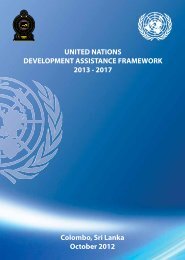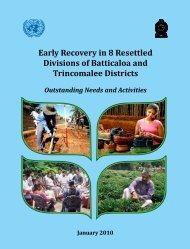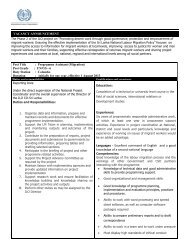Sri Lanka Human Development Report 2012.pdf
Sri Lanka Human Development Report 2012.pdf
Sri Lanka Human Development Report 2012.pdf
Create successful ePaper yourself
Turn your PDF publications into a flip-book with our unique Google optimized e-Paper software.
Galle, Matara, Vavuniya, Kurunegala and Anuradhapura,<br />
and in urban areas. In Colombo and Kandy, this may be<br />
the result of seriously ill infants dying while receiving care<br />
in tertiary hospitals there. In some areas, the rate increased<br />
from 2003 to 2007, including on estates, where it rose from<br />
13.6 in 2003 to 16.9 in 2007. In Batticaloa, it increased<br />
from 21.1 to 25.1 during the same period. Further studies<br />
are needed to determine the reasons for these changes.<br />
Maternal Mortality<br />
For more than six decades, <strong>Sri</strong> <strong>Lanka</strong> achieved considerable<br />
success in consistently reducing maternal mortality. It<br />
began heavily investing in maternal and child health<br />
Sustained, significant investment in health is an important<br />
reason for a steep decline in the maternal mortality rate:<br />
from 61 per 100,000 live births in 1995 to 39.3 per<br />
100,000 in 2006, according to estimates by the Family<br />
Health Bureau. Today, <strong>Sri</strong> <strong>Lanka</strong> has the lowest maternal<br />
mortality rate in the SAARC region, although regional<br />
disparities persist (Figure 3.3). Maternal mortality rates<br />
are highest in war-affected districts such as Killinochchi,<br />
Batticaloa, Ampara and Mullaitivu, and in Nuwara Eliya<br />
and Monaragala, which have high levels of poverty. Half<br />
of the population of Nuwara Eliya comprises the estate<br />
population whose health care options have begun to<br />
improve only recently.<br />
Figure 3.3: Maternal Mortality Rate by District, 2006<br />
Source: Institute of Policy Studies of <strong>Sri</strong> <strong>Lanka</strong> and United Nations <strong>Development</strong> Programme 2010.<br />
in the 1940s, which produced positive dividends over<br />
the years. The country now has a wide network of free<br />
maternal care services integrated with child care services.<br />
A well-trained cadre of Public Health Midwives provides<br />
domiciliary care; 98 percent of births take place in public<br />
health institutions; 65 and more than 98 percent of births<br />
are attended by skilled health care personnel, 74 percent<br />
of whom are medical doctors.<br />
Communicable Diseases<br />
<strong>Sri</strong> <strong>Lanka</strong> has nearly eradicated most vaccine-preventable<br />
diseases, as well as leprosy, malaria and Japanese<br />
encephalitis. Basic immunization coverage is close to 100<br />
percent (see Figure 3.4). According to available data, by<br />
12 months of age, almost 100 percent of infants have been<br />
vaccinated against tuberculosis (the BCG vaccine),<br />
Chapter 3 Bridging <strong>Human</strong> <strong>Development</strong> Gaps: Health 41






